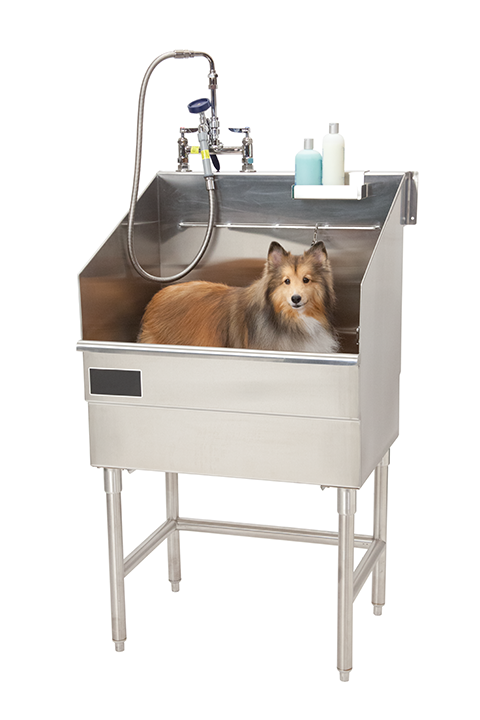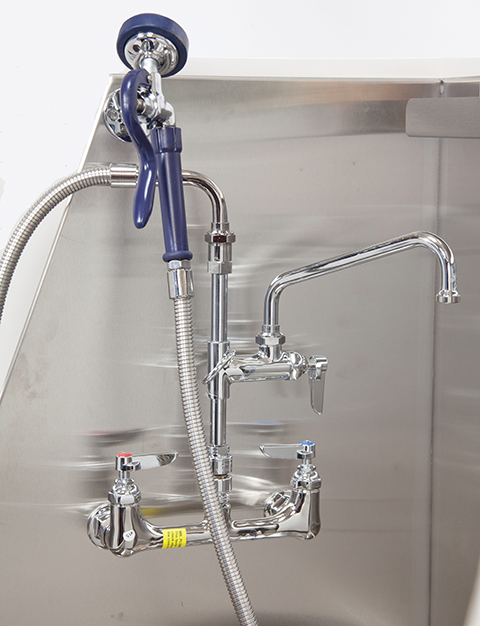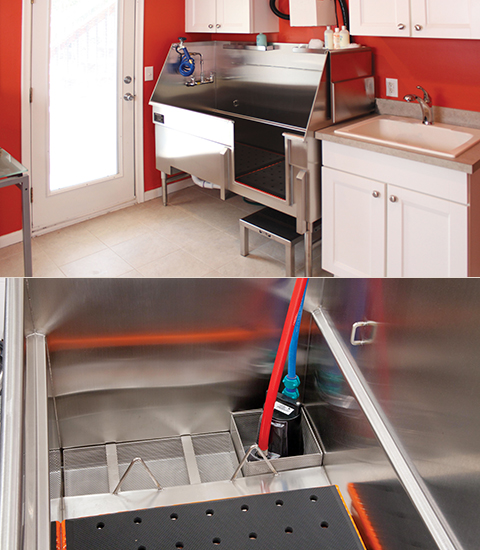
by Jeanne Caples, Mark Arndt, and Michael Chusid, RA, FCSI, CCS
While tubs for dog washing are a common feature of veterinary clinics, kennels, and professional pet-grooming services, these products are increasingly being installed in locations where dog-owners can wash their own pets. Many multi-family housing developments, apartment buildings, and residential condominiums now offer dog-washing rooms in addition to exercise yards in an attempt to attract more animal-owning tenants.
Hotels and resorts have also installed dog-wash facilities to attract some of the 30 million people in the United States that travel with pets annually, according to Travel Industry Association of America. Additionally, military bases that previously had grooming facilities solely for canine corps now offer the same to troops and their families, making bases more pet-friendly. Further, DIY dog-wash stations are increasingly popular in pet stores, at beaches and outdoor recreation areas, and even as freestanding vending stations.
Regarding this trend, The Wall Street Journal, states:
Due in part to the trend of Americans delaying getting married and having children until later in life, pet-ownership has hit an all-time high. In the U.S., 68% of households, or 82.5 million, included at least one pet in 2012, according to the American Pet Products Association, up from 62%, or 72.9 million, in 2010. Spending is hitting highs as well. In 2012, $53.33 billion was spent on pets, up from $41.2 billion five years prior.
Additional testimony is provided in a survey conducted by a real estate rental company. When asked what amenities they look for when choosing a home in a multi-unit property, “pet amenities” was selected by 39 percent of respondents, second in popularity only to “outdoor amenities” (47 percent) and ahead of “fitness amenities” (37 percent).
Within any cohort of dog owners, the frequency of dog-washing has increased. Instead of bathing a dog once a season, for example, many pets are now groomed every two to six weeks, or as often as needed to keep them clean and odor-free. Further, washing a dog in the backyard with a hose has shifted to a deluxe treatment with various specialty shampoos, conditioners, and other grooming aids.
In addition to quantitative changes, there appear to be qualitative changes in the relationship between many dogs and their owners. Many dogs are not just considered the family pet, but as a family member. For many, his or her closest companion is a dog and personally bathing and grooming a pet is a way of expressing affection.
Beyond social trends, it appears humans are hardwired to bond with dogs. A recently published paper suggests a neurobiological basis of human-pet relationships:
There is compelling evidence from clinical and laboratory studies that interacting with pets can be beneficial to the physical, social, and emotional wellbeing of humans. Several previous studies have found that levels of neurohormones like oxytocin—which is involved in pair-bonding and maternal attachment—rise after interaction with pets, and new brain imaging technologies are helping us begin to understand the neurobiological basis of the relationship.

The following are some additional ways bathing a dog can contribute to the well-being of both the pet and the owner:
- the hands-on experience of bathing a dog strengthens the bond between pet and owner;
- access to a pet care room in a residence or multi-family building provides a convenient, faster way to bathe a pet without leaving the premises, freeing up the owner’s time;
- a pet owner can detect new problems that may arise on the animal’s skin, and can find and remove any debris on the skin or coat that may cause a problem if left undetected; and
- bathing a pet reduces the amount of pet dander that can cause allergies for humans, and reduces pollen exposure for both pets and people in the household.
Tub options
Many pet owners wash their dogs in the same bathtubs used by the human occupants. While this method can lead to messy, wet bathrooms, there is an initial cost advantage since the tub is usually standard equipment in a residence and does not occupy additional floor space. For a multi-family property owner, however, this apparent savings can be offset by ongoing maintenance needs to clear drains clogged with hair and the premature replacement of tubs scratched or damaged by a dog’s nails.
Tubs designed for building occupants have additional disadvantages, including ergonomic injury due to lifting a reluctant dog into and out of the tub, and kneeling on an uncomfortable, hard bathroom floor. In addition to being visual blemishes, scratches and worn surfaces are more difficult to disinfect and inadequate disinfecting can lead to diseases being transferred pet-to-pet (and pet-to-human) if a dog-washing facility is shared by building tenants.
Although human-use tubs can be elevated to overcome the difficulty of kneeling while tending to a dog, this is impractical as a dog owner may not be able to lift the dog over the elevated side of the tub and risks problems associated with injuries. Stairs into an elevated tub can be costly in terms of both construction and the floor space they occupy.
Tubs made from ceramic tile offer visual appeal and can be made with tile and grout resistant to scratching and chemicals used to disinfect the tubs. However, tiled tubs require design, detailing, framing, and waterproofing in addition to tile work. It is generally more affordable to use factory-fabricated tubs that can be delivered to a job site ready for installation and final plumbing connections.
Most architectural-grade dog tubs are fabricated from stainless steel sheet. Grade 304 stainless steel with a No. 3 coarse abrasive, mechanically applied finish—the same is widely used for commercial kitchen countertops and equipment—has demonstrated good serviceability. While thinner material may be acceptable for light-duty tubs in single-family residences, 14-gage (1.9-mm, [0.07-in.] thick) sheet will stand the test of time and heavy use in multi-family facilities.
All joints should be welded for durability and watertightness and all tub edges smoothed and, preferably, hemmed to eliminate sharp edges that could pose hazards. A rolled—rather than blunt
or squared—front edge is most comfortable for the person or dog that may be leaning over it.
According to the Pet Industry Sustainability Coalition, “the lifespan of a product is a critical component to its environmental footprint.” Stainless steel tubs contain approximately 60 percent recycled material and are fully recyclable, and are unlikely to be scraped. When the tub is no longer needed in its original location, it can be salvaged for reuse in another facility.
Professional groomers may have several tubs to accommodate big and small animals. However, a multi-family facility has to consider the gamut of animals that may use it. If a building limits tenants to small animals, it may be practical to use a small- or medium-sized tub. Tubs as small as 810 x 460 x 180 mm (32 x 18 x 7 in.) are convenient for miniature breeds and also allow the bather to work conveniently at counter height.

Multi-purpose tubs can accommodate a wider range of breeds. For example, tubs with a 1520 x 690 mm (60 x 27 in.) footprint and a front that is 915 mm (36 in.) above floor is large enough for Newfoundlands and Saint Bernards, yet can be equipped with features useful for bathing smaller animals. These features can include:
- a removable panel or door that allows dogs easy access into the tub as the tub’s bottom is less than 500 mm (20 in.) above the floor;
- stools with non-slip feet and top and low enough to stow under the tub when not in use, can assist small dogs and large creatures with reduced mobility (tubs with ramp entrances are also available, but should be considered only for use by professional groomers); and
- adjustable grates can be placed at the bottom of the tub or raised 300 mm (12 in.) above the tub’s bottom—the raised platform allows small dogs to see over the top of the tub so they are less anxious, and it can also be used as a work table for drying, brushing, and grooming.
The grates also allow water to drain away from a dog. This is important since dogs should not be bathed while standing or immersed in water to prevent against recontamination with dirt and soap residues that could cause irritation. A resilient, drainable mat on top of the platform should be specified to prevent injuries that could be caused if toenails or paw pads got caught in the grating. The mats are also more comfortable and slip-resistant for dogs and provide a more reassuring surface for them to stand on.
Most dog tubs are designed to be placed against a wall, with access only from the front. They have a high splash panel against the back wall and angled side panels. There are also three-sided models, installed like a peninsula so a dog can enter from the far end and be washed by people standing on both sides. The exposed sides, however, increase the potential for a dog to escape from the tub, and for overspraying and splashing of soap and water that will create more mess and greater slip hazards.
Stainless steel tubs are usually installed on legs that can be adjusted for leveling, allowing easy cleaning and access to plumbing lines under the sink. If preferred, however, a tub can be set onto cabinetry or another base.
Specifications should call for tether points to attach a short lead with which a dog can be restrained to prevent injury to itself or the bather. Another convenience is to call for shelves that can
be attached to the splash panel so soap and grooming tools can be kept close-at-hand.
Plumbing, HVAC, and electrical
The location of the drain is usually at the end of the tub furthest from the tub’s entry door, and should be shown on the floor plan. The bottom of the tub should be pitched to drain and the drain protected against hair clogs. Many breeds have a double layer of hair—an undercoat for insulation and an outer coat for wear—and prodigious quantities of hair can be shed during bathing. Typical drain strainers can be overwhelmed by this. A large, basket-type strainer is effective, however, as it can hold a large quantity of hair and be easily cleaned. The basket should be recessed into a trough
to keep the shed hair away from the dog.
For professional groomers, the trough also serves as a sump that enables the use of a water recirculating pump. As a pump’s inlet must be submerged to a sufficient depth, a flat-bottomed tub can require 23 to 38 L (6 to 10 gal) of water. Water consumption can be reduced to just 7 to 11 L (2 or 3 gal) if only the sump has to be filled. Less water also means less soap, which reduces the cost of washing the dog and the environmental impact of chemicals washed down the drain. The pumps are not recommended, however, for do-it-yourself installations unsupervised by an experienced operator. A floor drain should also be considered to simplify housekeeping.
On the water supply side, domestic water pressure usually suffices for DIY bathing. If pressure is low, however, a supplemental pump can be considered for professional grooming facilities. Hot-water demand should be estimated and supplied via the building’s water lines or a local tank or tankless heater.
Faucets are usually located at the same end of the tub as the drain. Consideration should be given to the use of a temperature-regulating valve—sudden fluctuations could frighten or injure the dog.
Spray valves used in commercial kitchens can have needle-like force unacceptable with animals. Professional-grade systems include lightweight aluminum spray valves with coiled plastic hoses; chrome-plated brass valves with metal-clad hoses are heavier but more durable. Backflow preventers, usually required by code, should be positioned on the base faucet, rather than on the hose or hand piece in order to reduce the weight a bather has
to support.
The spring-loaded grip on a spray valve makes it convenient to turn water on and off as needed. This results in significantly less water consumption than if water had to be turned on and off with handle-type faucets.
For a general water supply, a utility spigot should be specified in the tub unless a service sink or other water source is available elsewhere in the room. If it will be used for drinking water, one should check with the manufacturer as pet care products are typically exempt from National Sanitation Foundation (NSF) potable water requirements.
The design of the room’s ventilation system should be similar to a traditional bathroom with consideration for exhaust air for odor and humidity control, and maintenance of an air temperature comfortable to a wet bather. If the bath is along an exterior wall, consideration should be given to potential condensation on windows and to placement of vapor barriers in insulated construction.
The human bathroom is also a good model for electrical services. Lighting should be specified to minimize glare and provide good color rendition. Electrical receptacles near tubs, for dryers, recirculating pumps, and other equipment, must be on a ground fault circuit interrupter (GFCI).

Room layout and finishes
In a multi-family facility, management will have to decide whether to provide towels or let tenants bring their own. In the former case, a shelf for clean towels and a hamper for wet towels should be provided. A quick toweling-off may be sufficient for breeds with short, smooth hair, but dogs with longer hair will benefit from a canine-grade blow dryer. The dryers, usually wall-mounted and equipped with a flexible hose, deliver high velocity air to blow water out of the dog’s coat, and reduce drying time.
Finishes should be easy to maintain and resistant to splashing and moisture. The flooring should be washable, slip-resistant, and able to resist abrasion by the dogs’ nails; seamless floor finishes with integral base coves should be considered. Resilient mats are recommended for professional groomers as they may be on their feet for hours at a time.
Dogs bark, especially if the tub area doubles as a dog play room. Finishes, particularly the ceiling, should provide noise absorption to reduce sound intensity within the room. Rooms should also be designed to prevent excessive noise from entering tenant units and other adjacent spaces.
As appropriate, a dog-wash room can be equipped for feeding, play equipment, and canine drinking fountains. Additionally, pet tubs frequently do double duty and may be used to clean large household items and recreational gear.
While bathing facilities are frequently offered at no charge to tenants, some building owners will install coin- or token-operated meters for water and dryers. The temptation to vend shampoo and other dog care products should be avoided as it is impractical to stock the full range required to care for dogs with different types of hair and skin conditions.
An apparent trend in multi-family housing is to move clothing washers and dryers from shared laundry rooms into tenant spaces. If an existing building has an obsolete laundry room, it can be conveniently converted to a dog-care room as water and drainage connections are already in place. In other buildings, placing the dog wash in the parking garage or near the building’s entry enables the animals to be cleaned before tracking dirt into the building. For a building with a dog exercise area, it will be convenient to locate the washing area nearby; in mild climates, tubs can even be located outdoors under a canopy.
Some architects have gone so far as to place the dog room in a storefront location, visible from the public sidewalk, to communicate the building’s dog-friendly nature. Like parents socializing at their children’s playground, dog facilities can become a social gathering place or community hub.
Conclusion
Specialized dog-bathing facilities are not new phenomena. A treatise on bathing facilities, published in 1908, states, “It is, at best, a difficult problem to keep a dog in a city, and the greatest trouble arises from the fact that there is very little or no opportunity to bathe the dog.” The author, a civil engineer, describes dog-washing facilities built as early as 1901 and raises concerns that must still be addressed by specifiers, including:
- durability of finishes;
- acoustic isolation;
- ventilation;
- water supply;
- drainage;
- comfort; and
- safety.
The engineer ends his report about these first experimental dog-washing facilities by asking “whether the income derived from the dog bath tickets would be sufficient to warrant the installment of this useful feature.” One hundred years later, that question can be answered with a tail-wagging affirmative.
Jeanne Caples and Mark Arndt are the founders and owners of Forever Stainless Steel and Bathtubs for Pets. They are the inventors of several patented features now used in dog bathtubs. They can be reached at jeanne@foreverstainlesssteel.com and mark@foreverstainlesssteel.com.
Michael Chusid, RA, CCS, FCSI, is an architect, a Fellow of CSI, and a Certified Construction Specifier. He is a frequent contributor to The Construction Specifier, and a consultant to building product manufacturers. Chusid can be reached through his blog, www.buildingproduct.guru.




